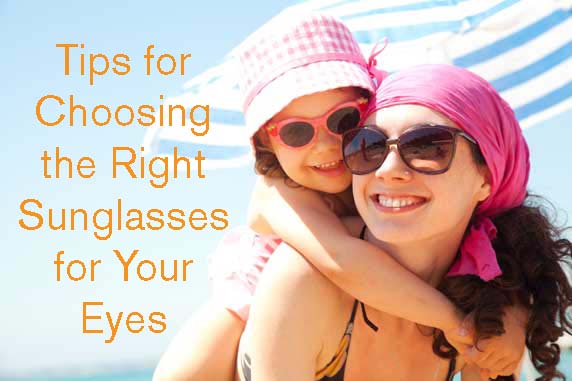Sunglasses can give you instant James Dean cool, Audrey Hepburn glamor, or the rock star hipness of Bono. But they are much more than a fashion accessory. Sunglasses are an essential tool in safeguarding the health of your eyes and the surrounding tissue.
Here’s what you need to know about what sunglasses can do for you (apart from style) and how to choose them.
Eye on UV Risks
Just as the sun’s ultraviolet (UV) rays can damage skin, they can also harm the lens and cornea of the eyes.
UV radiation increases your odds of getting cataracts, which cloud the eye’s lens and lead to diminished eyesight. It has also been linked to macular degeneration, a treatable, but an incurable disease of the macula, a part of the retina that is essential for sharp vision.
Other UV-related eye problems are pterygium and pinguecula. A pterygium occurs when the conjunctiva, the tissue that lays over the white of the eye, grows into the cornea. A pinguecula is a yellowish bump of tissue on the white of the eye.
Sunlight that bounces off highly reflective surfaces such as snow, water, sand, or pavement can be especially dangerous.
Photokeratitis is a corneal sunburn that’s also known as snow blindness. As the name suggests, skiers and snowboarders are particularly vulnerable to this temporary but acutely painful condition. In photokeratitis, tiny blisters form on the surface of the cornea. It’s a condition that will generally resolve on its own with proper medical treatment, but it’s uncomfortable enough to spoil your vacation.
Sunglasses play a vital role in shielding the fragile tissue around the eye. This skin, including the eyelid itself, is very thin and vulnerable to skin cancer, and that’s especially troubling since dermatologists are reporting an epidemic in all types of skin cancer. Sunglasses can not only help protect against basal cell and squamous cell carcinomas and melanoma, but also against the formation of wrinkles like crow’s feet and the unsightly thickening of the skin that can sometimes be caused by UV exposure.
Make Sunglasses a Daily Habit
Like sunscreen, sunglasses should be worn whenever you’re outdoors, year-round. Just as we’ve learned that you can get a really nasty sunburn on an overcast, hazy day, you’re exposing your eyes to damaging UV rays on these days, too.
Sunglasses are especially important for children, as UV eye damage is cumulative over a lifetime. So, it’s important to make wearing sunglasses a habit early in life. What’s more, children’s eyes are especially vulnerable because they’re still developing.
How to Pick the Right Pair of Sunglasses for Optimal Protection
Protecting your eyes from the sun begins with picking the right pair of sunglasses. Here’s advice from eye care experts.
• Look for Complete UVA/UVB Protection
• Choose sunglasses that provide full protection against ultraviolet light. Look for a label or a sticker that says one or more of the following:
– Lenses block 100% of UVB and UVA rays
– Lenses meet ANSI Z80.3 blocking requirements. (This refers to standards set by the American National Standards Institute.)
– UV 400 protection. (These block light rays with wavelengths up to 400 nanometers, which means that your eyes are shielded from even the tiniest UV rays.)
Choose the Right Hue
The coating that blocks UV radiation is clear, so a darker lens isn’t necessarily more effective than a lighter one. But hue does play an important role in color perception.
Yellow or rose-tinted lenses can make it difficult to distinguish changes in traffic lights. Gray, green, and brown lenses minimize color distortion and are a better choice when you’ll be behind the wheel.
Opt for Polarized Lenses If You Spend a Lot of Time on Water
Polarized lenses reduce glare by filtering out the reflected sunlight that bounces off surfaces like water or pavement. They’re a good option for boaters or water skiers, and they can cut down on glare from flat, smooth surfaces like road pavement or the hoods of cars.
The downside: It can be difficult to read your cell phone, GPS device, or a liquid-crystal display on a dashboard or ATM machine with polarized lenses.
Be aware that polarization has nothing to do with UV protection. So check the label to make sure the sunglasses provide full UV filtering.
Consider the Quality of the Lenses
Eyecare experts agree that price isn’t a gauge of UV protection. But very inexpensive sunglasses are likely to contain lenses that are stamped out of a mold rather than ground and polished, and that can affect optical quality. Consistency is a concern with lower-priced glasses. You might find one pair that offers great clarity and another that’s the very same brand and model and highly distorted.
To test optical quality, the FDA suggests focusing on a vertical edge or line. Move your head back and forth, allowing your eyes to sweep across the lens. “If there is any wiggle in the line,” the FDA guidelines say, “then the lenses may have an optical defect and you should choose another pair.”
Bigger is Better
Wraparound sunglasses offer the broadest protection against UV damage because they block more of the light that hits your eyes from the sides. Sunglasses with large lenses and wide temples provide the next-best protection. Large lenses cover a wider area of skin so there’s a decreased window for UV penetration. Sunglasses that come down to your cheekbones are a good choice.
Fit Matters
Sunglass frames should fit snugly on your nose and ears without pinching or rubbing. To prevent light from hitting your eyes from overhead, choose a pair that fits close to your face around the brow area, but not so close that your eyelashes are hitting the lenses, Royal says.
Whether you opt for high-priced designer sunglasses or a more affordable pair you find at your drugstore, you can easily find sunglasses that are flattering and functional. And protecting your eye health is one sunglass trend that will never go out of style.
Sources:
http://www.webmd.com/eye-health/features/how-to-pick-good-sunglasses?page=3







